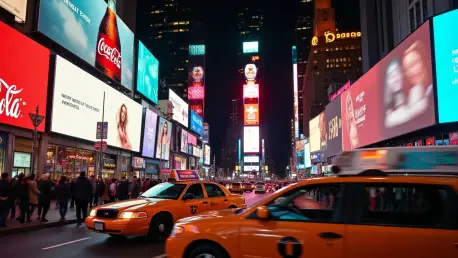In recent years, there has been a significant shift in the strategies employed for political advertising, particularly in Australia, where trust in digital platforms is waning, and traditional communication methods are making a comeback. Out-of-Home (OOH) advertising, such as billboards and bus shelters, has gained prominence due to its ability to deliver clear, controlled messages without the interference of comment sections, pop-ups, or algorithms. This direct form of communication is becoming imperative as digital platforms, like Meta, reduce third-party fact-checking for ads, leading to increased uncertainty. In the context of a shifting political landscape, where digital misinformation concerns are mounting, OOH advertising is emerging as a key player in election strategies.
The Evolving Role of OOH in Political Strategy
Meeting the Demand for Trusted Communication
OOH advertising’s resurgence coincides with a growing mistrust in digital media platforms, driven by concerns surrounding misinformation and content accuracy. These platforms often lack rigorous oversight, leading to a landscape where a message’s authenticity can be easily questioned. In contrast, OOH provides an environment free from these digital distractions, offering audiences direct and unadulterated messages. As it is integrated into daily life, OOH captures attention through its vibrant displays, making it hard to ignore.
The strategic placement of OOH ads in high-traffic areas such as highways, public transportation hubs, and prominent city locations ensures message delivery without interruption. This visibility, combined with message clarity, is invaluable when addressing electorates. As voters navigate a deluge of information, consistent and clear communication aids in building credibility. Therefore, it’s no surprise that political strategists are increasingly relying on OOH as a medium because it offers a blend of both reach and integrity that is hard to parallel in the digital age.
Expanding Reach and Flexibility with DOOH
The infusion of technology has expanded OOH’s capabilities, particularly with the advent of Digital Out-of-Home (DOOH) advertising. DOOH takes traditional outdoor media a step further, offering dynamic content that can be adjusted in real-time based on various factors like time, audience demographics, or even weather conditions. This adaptability is what makes DOOH particularly appealing in political campaigns, as it allows for precise location-based targeting and the dissemination of timely messages that reflect current campaign needs or events.
The flexibility afforded by programmatic DOOH enables campaigns to pivot swiftly, deploying new content to address emerging voter sentiments or electoral challenges. This capability contrasts sharply with the static nature of many digital ads, which can become obsolete as a campaign progresses. Additionally, DOOH allows for the amplification of pivotal campaign moments, ensuring key messages reach crucial swing electorates. Its potential for high-impact visuals and narrative storytelling further bolsters its position within political advertising strategies. As election spending continues to rise, the blend of reach and flexibility offered by DOOH presents a compelling avenue for engaging with constituents.
OOH as a Tool for Civic Engagement
Disseminating Verified Information
Beyond its role in campaigns, OOH serves an important function in supporting civic engagement by distributing verified information to the public. Political advertising often wrestles with misinformation, a battle that OOH is well-equipped to fight given its nature. In the lead-up to elections, OOH platforms can act as conduits for official messages, aiding in the reduction of false or misleading information that may circulate online. Whether it’s updating the public on voting dates, locations, or eligibility requirements, OOH can provide a reliable source of information, contributing to a well-informed electorate.
The consistency and trustworthiness of OOH advertising reinforce its capability as a tool for disseminating public interest messages. This role is not limited to election cycles but extends to broader purpose communication, fostering public awareness on social issues and public safety alerts. The non-intrusive nature of OOH makes it an effective medium for factual content, countering the often speculative or inflammatory nature of viral online content. By maintaining message integrity across societal issues, OOH reinforces its standing as a pillar of reliable communication.
Fostering Voter Turnout and Engagement
OOH’s visibility and steady nature make it an ideal method for boosting voter turnout. By ensuring that electoral messaging remains constant, clear, and accessible to all audience segments, OOH campaigns contribute to heightened voter awareness and participation. In various countries, voter turnout campaigns have been shown to benefit significantly from well-executed outdoor advertising strategies. This engagement typically revolves around inspiring citizens to act decisively in civic matters.
As campaigns increasingly target detailed electorate demographics, OOH provides avenues for nuanced messaging that speaks directly to community concerns or interests. With studies indicating rising levels of digital disengagement due to ad saturation and content overload, OOH stands strong as a reminder of essential civic duties like voting. The election landscape continues to evolve, with OOH adapting and reaffirming its position as a sustainable and respected medium for reaching voters. As such, it remains at the forefront of political strategy considerations, driving both message outreach and civic participation.
The Future of Political Advertising
Over the past few years, political advertising strategies have witnessed a noteworthy transformation, especially in Australia. With growing skepticism towards digital platforms, there’s been a resurgence in traditional advertising methods. Out-of-Home (OOH) advertising, encompassing billboards, bus stops, and similar mediums, has regained traction. This resurgence is largely because OOH media offers the advantage of delivering straightforward, unfiltered messages, free from the disruptions of comment sections, algorithms, and pop-ups that often clutter digital spaces. As platforms like Meta decrease their third-party fact-checking, uncertainty creeps into the reliability of digital ads. Consequently, in the evolving political landscape, where misinformation is a rising concern, OOH advertising is gaining a significant foothold in election strategies. It offers a stable and reliable avenue to communicate political messages directly to the public without the risk of digital distortion, proving essential for effective political campaigns.









